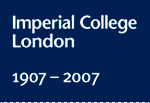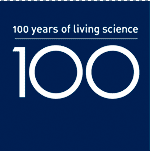Timeline
- 1845 – 1899 |
- 1900 – 1909 |
- 1910 – 1919 |
- 1920 – 1929 |
- 1930 – 1939 |
- 1940 – 1949 |
- 1950 – 1959 |
- 1960 – 1969 |
- 1970 – 1979 |
- 1980 – 1989 |
- 1990 – 1999 |
- 2000 – present
Imperial College 1900 - 1909
World
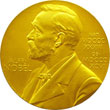 1901 - First Nobel Prizes Awarded
1901 - First Nobel Prizes Awarded
Swedish chemist Alfred Nobel was the inventor of dynamite. Not wanting to be remembered for creating an instrument of death, Nobel created a will that left the bulk of his fortune to the establishment of five prizes (physics, chemistry, physiology or medicine, literature, and peace). On December 10, 1901, five years after Alfred Nobel's death, the first five Nobel Prizes were awarded.
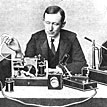 1901 - First Trans-Atlantic Radio Signal
1901 - First Trans-Atlantic Radio Signal
Acknowledged as the father of radio, Guglielmo Marconi successfully transmitted the first transatlantic radio signal on December 12, 1901. The signal was a letter S sent in Morse code using a spark transmitter located at Poldhu in Cornwall England and was received by Marconi himself at Signal Hill, St. John's in Newfoundland.
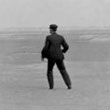 1903 - First flight by the Wright Brothers
1903 - First flight by the Wright Brothers
The Wright brothers, Orville and Wilbur are generally credited with making the first controlled, powered, heavier-than-air human flight on 17 December 1903.
back to top
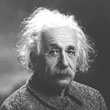 1905 - Albert Einstein published the Theory of Relativity
1905 - Albert Einstein published the Theory of Relativity
Albert Einstein shook the foundations of physics with the introduction of his Special Theory of Relativity in 1905, and his General Theory of Relativity in 1915. The first showed that Newton's Three Laws of Motion were only approximately correct, breaking down when velocities approached that of light. The second showed that Newton's Law of Gravitation was also only approximately correct, breaking down in the presence of very strong gravitational fields.
back to top
College
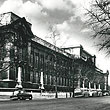 1900 - Building work commences on the Royal College of Science
1900 - Building work commences on the Royal College of Science
As the Royal School of Mines and Royal College of Science continued to develop, there were more than double the applications for student places than could be physically accommodated. A new building was needed especially for chemistry and physics, with large, modern, well equipped, laboratories.
In 1898, the 1851 Commission offered the land opposite the Imperial Institute, valued at £100,000 if government funding was made available for construction of the building. The architect for the Royal College of Science building was Sir Aston Webb and was completed in 1906.
back to top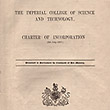 1906 - Board of Education Departmental Committee Report on the need for a higher technical education institution
1906 - Board of Education Departmental Committee Report on the need for a higher technical education institution
The Board of Education Committee report, in 1906, indicated that a high level scientific and technological educational institution should be established, combining Royal College of Science, the Royal School of Mines and the City & Guilds College.
In educational and government circles, the debate about the need for a ‘London Charlottenberg’, a British higher technical education institution with applications to industry, had been continuing from the 19th century. The grouping of the RSM, RCS and C&G in South Kensington lent weight to the proponents’ arguments for such an institution.
In 1904 the Board of Education instituted a Departmental Committee to investigate the ‘present working of the RSM, RCS and C&G to see how they could best be utilised in the development of an integral higher technical and scientific institution. The Preliminary Report in February 1905 was positive about the integration into one body of the three institutions, but this required co-operation of the Board of Education and the government (for financial support) and the City and Guilds of London Institute. The private benefactors would contribute to building and equipment costs for the new institution.
In November 1905 the government funding was confirmed. The final Report of the Committee was published in January 1906, recommending combining the institutions into one. The 1851 Commissioners would make land available.
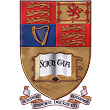 1907 - Signing of the Charter forming Imperial College
1907 - Signing of the Charter forming Imperial College
The final Report of the Board of Education Committee was published in January 1906, recommending combining the Royal College of Science, the Royal School of Mines and the City & Guilds College into one institution.
Negotiations on detail amongst the governing bodies of the institutions continued and in February 1907, the Board of Education issued a letter outlining its deliberations. On 26 March at the Old RSM old students dinner, the President of the Board of Education, Mr McKenna, read out some of a draft of the Charter of Imperial College. A list of members of the Governing Body was issued on 1 July and the charter forming Imperial College, was granted on 8 July.
back to top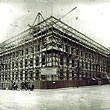 1909 - Construction commences on Goldsmith's Extension and Royal School of Mines
1909 - Construction commences on Goldsmith's Extension and Royal School of Mines
In 1909, construction commenced on the Goldsmith's Extension and Royal School of Mines. It had become clear that the new institution, Imperial College, needed a new building to begin its expanded brief in. The 1851 Commission granted land, and an extension to the City and Guilds Building was funded by the Goldsmiths Company with the Royal School of Mines building being funded by benefactions from the Wernher, Beit and Company and the Bessemer Memorial Fund equipping the Metallurgy laboratories. The architect for the construction was Aston Webb.
Exactly two years after the creation of Imperial College, the foundation stone was laid on 8 July 1909 by Edward VII.
back to topPeople
 Martha Annie Whiteley (1866-1956)
Martha Annie Whiteley (1866-1956)
Martha Annie Whiteley was the first woman to hold a position on the teaching staff at the Royal College of Science. She joined the RCS as a teaching scholar in the Chemistry Department in 1904, was an Assistant in 1905, a Demonstrator in 1908; a Lecturer in 1914 and Assistant Professor (equivalent of Reader) in 1920.
She fought for the admittance of women to the Fellowship of the Chemical Society between 1904 and 1920 and won. She was made a Fellow of the Royal Institute of Chemistry in 1918. She was awarded the OBE in 1920 for her chemical work for the 1st World War. She was supportive of all women at Imperial College, using her influence to obtain increased cloakroom facilities for women staff and students in 1910.
At the request of the then Rector Sir Alfred Keogh, she founded Imperial College Women's Association in 1912. Keogh said of her: "She has an extraordinary power of expression which in some way enables her to obtain a very remarkable influence in the College, and a charm of manner particularly desirable in a teacher.... here you have no ordinary woman. I know of no one more likely to inspire women students to great things in science than Miss Whiteley".
back to top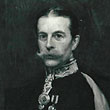 Robert Offley Ashburton Crewe-Milnes, 1st Marquess of Crewe (1858-1945)
Robert Offley Ashburton Crewe-Milnes, 1st Marquess of Crewe (1858-1945)
The Earl of Crewe became the first Chairman of the Governing Body of Imperial College.
He had a distinguished career in parliament and in diplomatic service and an interest in education. He was Chairman of the Governing Body of Imperial College 1907-1922, President Board of Education 1916; Chancellor of Sheffield University and Chairman of London County Council 1917.
back to top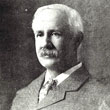 1908 - Henry Taylor Bovey (1850-1912)
1908 - Henry Taylor Bovey (1850-1912)
Henry Taylor Bovey FRS, Fellow Royal Society of Canada and Fellow of Queen’s College Cambridge was the first Rector of Imperial College.
Born in Devon, he was educated at Cambridge University and trained in engineering with Sir George Lister who was involved with Mersey Docks and Harbour Board. Here, Bovey developed his talent for structures as an assistant engineer.
Following an accident which affected his lungs, it was necessary for him to live in a more congenial climate and co-incidentally he was offered the Chair of Engineering at McGill University Montreal in 1877. The Engineering School needed reorganising and re-directing. Bovey gained the support of the Principal to undertake this and proved his vision and organisational skills by creating an outstanding Engineering Faculty. This included benefaction for a new building, an example of his capacity for making useful connections.
However, his health was deteriorating and he deliberated when offered the position of 1st Rector of Imperial in 1907. In May 1908 the appointment was confirmed, but he only gave two years to Imperial due to his health and resigned at the end of 1909.
He died in Eastbourne in 1912. He was a founder member of the Society of Civil Engineers and the Liverpool Society of Civil Engineers.
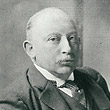 Beits & Wernher
Beits & Wernher
Early 20th Century Industrialists supported the RSM, Imperial College and Students Union Buildings and Science scholarships including, to a great extent, Sir Alfred Beit, Sir Otto Beit and Julius Charles Wernher.
Sir Alfred Beit (1853-1906) was a South African diamond mine owner and financier, life director of De Beers Consolidated Mines Ltd; and joint owner Wernher, Beit and Co. Alfred Beit was a philanthropist who funded mining education, especially the RSM and Imperial College, establishing the Beit Trust. A statute of him by Paul Montfort flanks one side of the entrance to the RSM.
Sir Otto Beit (1865-1930) FRS KCMG 1st Baronet, Brother of Sir Alfred; financier and philanthropist, funded construction of the Beit Quad, Students Union building and hostel; founded the Beit Fellowships for Scientific Research at Imperial College. He was also a member of the Governing Body from 1912. A plaque depicting him by Omar Ramsden is situated in the Beit Quad entrance.
Julius Charles Wernher (1850-1912) 1st Baronet, Luton Hoo was a South African diamond mine owner and financier; joint owner Werhner, Beit and Co. Wernher was a philanthropist and fine art collector. He was a member of the Board of Education Departmental Committee which recommended the foundation of Imperial College. A statue of him by Paul Montford flanks one side of the entrance to the RSM.
back to top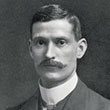 Alexander Gow
Alexander Gow
Alexander Gow became the First Secretary of Imperial College 1908 and was made Fellow of Imperial in 1946.
He was educated at Borough Road College 1887, where he was a staff member from 1890-1897. He gained a University of London BSc in 1893. Gow was then Chief Science Master at County High School Isleworth and Organising Secretary for Technical Education, Hounslow, Middlesex.
He became a Cambridge University Scholar 1900 (B.A. Natural Science Tripos, Chemistry and Physics. M.A. 1906), becoming Principal of Warrington Technical School Director in 1903 and Principal of Blackburn Technical School 1904-1908 and then Director of Education in Blackburn 1905-1908, when he came to Imperial with his considerable educational and administrative acumen.
back to top© 2007 Imperial College London
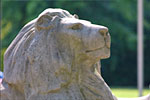
Through the first decade of the twenty-first century the campaign seeks to philanthropically raise £207 million from Imperial’s alumni, staff and friends, and donations from charitable foundations and industry.
Where your support can make a differenceGive now
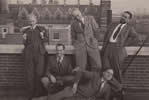
We’re celebrating 100 years of living science with 100 stories. We’ve collected some of them already, and invite you to share your own stories and memories.
